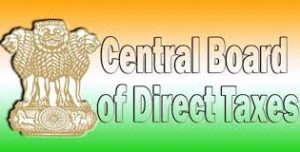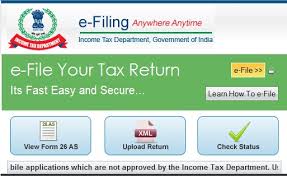
With barely five days left for the roll-out of the goods and services tax (GST), the GST Network (GSTN), a company that provides information technology systems for the GST, reopened registration for assessees on Sunday.

With barely five days left for the roll-out of the goods and services tax (GST), the GST Network (GSTN), a company that provides information technology systems for the GST, reopened registration for assessees on Sunday.
 The CBDT has notified new income-tax return forms (ITR forms) for the assessment year 2017-18. It has prescribed simplified version of ITR-1 with fewer columns. A new column has been inserted in ITR Forms to report cash deposits in banks above 2 lakhs during the demonetisation period, i.e., from November 9, 2016 to December 30, 2016.
The CBDT has notified new income-tax return forms (ITR forms) for the assessment year 2017-18. It has prescribed simplified version of ITR-1 with fewer columns. A new column has been inserted in ITR Forms to report cash deposits in banks above 2 lakhs during the demonetisation period, i.e., from November 9, 2016 to December 30, 2016.
CBDT had prescribed new ‘Form ITR 4 Sugam’ for taxpayers opting for presumptive taxation scheme. A new column has been prescribed to mention digital receipts as the rate of presumptive income is 6% for such receipts.
The new ITR forms prescribed are listed below:-
ITR_2 For Individuals and HUFs not carrying out business or profession under any proprietorship
ITR_3 For individuals and HUFs having income from a proprietary business or profession
ITR_4 For Presumptive Income from Business & Profession
ITR_6 For Companies other than companies claiming exemption under section 11
Changes in new ITR forms are as follows.
1) Simplified one page ITR Form for Salaried class taxpayers
[ITR 1 Sahaj] Now the Govt. has notified simplified one page form ‘ITR-1 Sahaj’ for individuals earning income from salary, pension, one house property and income from other sources. It has removed columns which are not frequently used by the taxpayers.New ‘ITR-1 Sahaj’ has retained those deductions which are most frequently used by the taxpayers, viz, under Section 80C, 80D, 80G and 80TTA.
If any taxpayer wants to claim deduction under any other provision of chapter VI-A he can specify the relevant Section in column titled as ‘Any other’. Schedules of TDS and TCS have been merged into one in order to make ITR 1 shorter and simpler.
However, new columns have been inserted to report dividend income and long-term capital gains exempt under Section 10(34) and Section 10(38) respectively.
2) Disclosure of cash deposits during demonetization
[ITR 1, 2, 3, 4, 5, 6, 7] A new column has been introduced in all ITR Forms to report on cash deposited by taxpayers in their bank accounts during the demonetization period, i.e., from November 9, 2016 to December 30, 2016. However, taxpayers are required to fill up this column only if they have deposited Rs 2 lakh or more during the demonetization period.3) Quoting of Aadhar Number
[ITR 1, 2, 3, 4] The Finance Bill, 2017 as passed by Lok Sabha has introduced a new Section 139AA requiring every person to quote Aadhar number in the return of income. If any person does not possess the Aadhaar Number but he had applied for the Aadhaar card then he can quote Enrolment ID of Aadhaar application Form in the ITR.It may be noted that firms are also required to Quote Aadhaar number of their Partner/members in new ITR 5. Further, in case of trust Aadhaar number of Author(s) / Trustee(s) / Manager(s), etc., are required to be specified in new ITR 7.
4) Income taxable at special rates
Unexplained income [ITR 2, 3, 5, 6, 7]
As per Section 115BBE any unexplained credit or investment attracts tax at 60% (plus surcharge and cess, as applicable), irrespective of the slab of income.
Now new columns have been inserted in ITR Forms under ‘Schedule OS’ to report such unexplained income under ‘Schedule SI’.
It may be noted that any taxpayer having unexplained income cannot opt for ITR-1 Sahaj.
Dividend above Rs 10 lakhs
As per Section 115BBDA the dividend received from domestic company is taxable at rate of 10% if aggregate amount of such dividend exceeds Rs. 10 lakh. New column has been inserted in ITR Forms to declare such dividend income in ‘Schedule OS’.
It may be noted that any taxpayer having dividend income above Rs 10 lakhs and covered under Section 115BBDA cannot opt for ‘ITR-1 Sahaj’.
Patent income
A new column has been inserted in ITR Forms to declare royalty income from patent developed and registered in India and chargeable to tax at 10% under section 115BBF.
5) Deduction under section 80EE
A new field has been provided in new ITR Forms under Schedule VI-A deductions to claim home loan interest under Section 80EE.
6) Declaration of value of assets and liabilities by Individuals/HUF earning above Rs 50 lakhs
[ITR 2, 3, 4] During 2016, the Govt. had introduced new Schedule requiring individuals/HUFs to declare the value of assets and liabilities if their total income exceeds Rs. 50 lakhs. Taxpayers were required to mention cost of immovable property, jewellery, bullion, vehicles, shares, bank and cash balance, etc.Now tax payers are also required to disclose address of immovable property and description of movable assets in new ITR Forms. Further, new fields have been introduced in ITR Forms for disclosure of ‘Interest held in the assets of a firm or AOP as a partner or member’. Such members/partners are also required to disclose name, address, PAN of the firm or AOP.
7) Registration number of Chartered Accountant Firm
[ITR 3, 5, 6] Now taxpayers are required to mention registration number of firm of Chartered Accountant which has done audit in ITR Forms.8) Bifurcation of receipt/expenses from business and profession in no account case.
[ITR 3, 5] In old ITR Forms there was no option to bifurcate income and expense of business and profession separately. All receipts were to be clubbed together and shown in ITR.Now in new ITR forms, there is an option to show receipts from business and profession separately.
9) Deduction of additional depreciation in case of asset put to use for less than 180 days in preceding year
[ITR 3, 5, 6] In case of purchase of an asset which is put to use for less than 180 days, additional depreciation shall be restricted to 50% for that year and remaining would be allowable in the succeeding year.In old ITR Forms, no column was there under ‘Schedule DPM’ to claim unutilized 50% additional depreciation in succeeding year. Now in new ITR Forms such column has been inserted to claim unutilized 50% depreciation.
10) Segregation of digital receipts and other receipts under presumptive taxation scheme
[ITR 4] As per the presumptive taxation scheme under Section 44AD, 8% of gross receipts or turnover will be deemed as income of the taxpayer. However, in 2017 Union Budget such limit has been proposed to be reduced to 6% for digital receipts of taxpayer.In new ITR form, new columns have been inserted to show turnover received through digital mode. Consequently, columns have been inserted to show presumptive income at 6% and 8%.
The Finance Act 2016, had introduced the presumptive taxation scheme for professionals as well. Now new ITR 4 Form shows an option to avail such presumptive taxation scheme for professionals under Section 44ADA.
11) Details of receipts as mentioned in Form 26AS under TDS schedule
[ITR 4] ITR 4 which is now applicable for taxpayer opting for presumptive taxation scheme has a new column under the ‘Schedule TDS2’ to show the receipts as mentioned in Form 26AS.12) Disallowance for non-deducting or non-payment of Equalisation levy
[ITR 3, 5, 6] The Finance Act, 2016 has introduced new provision to deduct 1% Equalization Levy on payment made for certain advertisement services paid to non-residents.Any default in deduction or payment of Equalization levy would attract disallowance of Section 40(a)(ib). In new ITR Forms a new column has been inserted under ‘Part A-OI’ to mention such disallowance under section 40(a)(ib).
13) Disallowance of any amount payable for use of railway assets
[ITR 3, 5, 6] Any sum payable by the assessee to the Indian Railways for the use of railway assets shall be allowed as deduction on actual payment basis as per section 43B.A new column has been inserted under ‘Part A-OI’ for disallowance under section 43B in case of non-payment of such amount on or before due date of furnishing return of income.
14) New schedule to report ‘receipt and payment’ account of a company under liquidation
[ITR 6] A new schedule ‘Part A-OL’ has been inserted in ITR 6 to furnish details of ‘receipt and payment’ account of company under liquidation.15) Changes related to ITR 7 in respect of Charitable Trusts
[ITR 7] Various changes have been introduced in the new ITR 7 form. Now trust is required to furnish following additional details in new ITR 7 – The government today notified a simpler, one-page form for filing income tax returns while making it mandatory to quote Aadhaar number and disclose bank deposits of more than Rs 2 lakh post demonetisation.
The government today notified a simpler, one-page form for filing income tax returns while making it mandatory to quote Aadhaar number and disclose bank deposits of more than Rs 2 lakh post demonetisation.
The Income Tax Return Form-1 (Sahaj) will replace the 7-page form, removing a plethora of columns on deductions from income claimed.
Sahaj can be filed by an individual having income of up to Rs 50 lakh from salary, house property and interest.
Currently, SAHAJ (ITR 1) is filed by salaried employees and ITR 2 by individuals and HUFs whose income does not include income from business.
The government has done away with form ITR 2A (used by individuals & HUFs not having income from business or profession and capital gains and by those who do not hold foreign assets).
Sahaj makes quoting of 12-digit biometric identifier Aadhaar number mandatory along with Permanent Account Number (PAN) and also seeks details of cash in excess of Rs 2 lakh that was deposited in bank accounts in the 50-day post demonetisation window.
ITR 2 and ITR 3 have a Schedule AL requiring assessees to declare their assets and liabilities at the end of the fiscal.
Only 6 crore out of 29 crore persons having PAN file income tax returns at present.
The e-filing facility for ITR-1 is enabled from April 1 and ITRs can be filed till the stipulated deadline of July 31.
While the old ITR form too had column to quote Aadhaar, the government has through an amendment to the Income Tax Act this week made quoting it mandatory.
“The Central Board of Direct Taxes has notified Income- tax Return Forms (ITR Forms) for the Assessment Year 2017-18. One of the major reforms made in the notified ITR Forms is the designing of a one page simplified ITR Form-1 (Sahaj),” CBDT said in a statement.
In the new form, parts relating to tax computation and deductions have been rationalised and simplified for easy compliance.
Besides personal details, an income tax filer needs to disclose only his income from salary or pension, one house property and other sources like interest. Thereafter, deduction claims are to be stated, followed by computation of taxable income.
Bank details are to be filled in the column following that. Details of advance tax, self-assessment tax payments and tax deducted at source come next.
In the column for providing bank details, cash deposited in excess of Rs 2 lakh during November 9 to December 30, 2016 has to be mentioned.
The rationalised ITR will “reduce the compliance burden to a significant extent on the individual tax payer,” the CBDT said, adding that the move would benefit more than two crore tax-payers who will be eligible to file their return of income in this simplified Form.
Instead of 20 columns of deductions in the old form, only four deductions claims in respect of Section 80C, 80D, 80G and 80TTA need to be filled.
“Simultaneously, the number of ITR Forms have been reduced from the existing nine to seven forms. The existing ITR Forms ITR-2, ITR-2A and ITR-3 have been rationalised and a single ITR-2 has been notified in place of these three forms,” it said.
Consequently, ITR-4 and ITR-4S (Sugam) have been renumbered as ITR-3 and ITR-4 (Sugam) respectively.
There will be no change in the manner of filing of ITR Forms and all the returns are to be filed electronically.
However, where return is furnished in ITR-1 (Sahaj) or ITR-4 (Sugam), an individual of the age of 80 years or more, an individual or HUF whose income does not exceed Rs 5 lakh and who has not claimed any refund in the return of income, have an option to file return in paper form.
At the time of filing the form, the taxpayer has to fill in PAN, Aadhaar number, personal information and information on taxes paid. TDS will be auto-filled in the form.
Post July 1, as per amendments to the Finance Bill 2017 as passed by the Lok Sabha, it would become mandatory for an assessee to provide the Aadhaar number or the number showing that he has applied for Aadhaar in the ITR.
Also ITR 4 (filed by Individuals & HUFs having income from a proprietary business or profession) will now be known as ‘Sugam’ and ITR-4S will be substituted.
“Going forward for AY 2017-18, the benefit of using the simplest ITR form i.e. ITR-Sahaj shall not be available to the following category of taxpayers: those earning total income of more than Rs 50 Lakh, those earning dividend income of more than Rs 10 lakh and those whose total income includes cash credits, unexplained investments, unexplained money etc,” said Nangia & Co Partner Suraj Nangia.
Similarly, ITR 4 (Sugam) cannot be used by the following category of taxpayers — those earning dividend income of more than Rs 10 lakh, those whose total income includes cash credits, unexplained investments, unexplained money etc.
“Owing to the aforesaid changes, taxpayers earning income for these sources will have to file a more detailed form containing disclosure in respect of their assets and liabilities, bank accounts etc,” Nangia said.

With a view to make its services available to its stakeholders in an efficient and transparent manner, EPFO had introduced Universal Account Number (UAN). Subscribers, who seed Aadhaar and Bank account details, to their UAN have the facility to submit claim forms directly to EPFO without the attestation of employers by preferring claims in Forms No. 19 (UAN), 10C (UAN) & 31(UAN).
To add further convenience, these forms now have been further simplified and replaced with a single page Composite Claim Form (Aadhaar). This new Composite Claim Form (Aadhaar), can be submitted without the attestation of employers.
For subscribers also, who are yet to seed Aadhaar and Bank details with their UAN, new Composite Claim Form (Non-Aadhaar) replaces the existing Forms No. 19, 10C & 31. The new Single page Composite Claim Form (Non-Aadhaar), can be submitted with the attestation of employers.
Instruction sheet for filing the Composite Claim Form (Aadhaar):
1. The Composite Claim Form (Aadhaar) is applicable in cases where a member’s complete details in Form-11 (New), Aadhaar number and bank account details are available on the UAN Portal and UAN has been activated. Such members can submit this form directly to the concerned FPFO office, without attestation of claim form by the employees.
2. Purpose of advance and documents requited: (The purpose may be on of the following):
i) Housing Loan/ Purchase of site/ house/ flat or for construction/ Addition alteration in existing house/ Repayment of housing loan: No document is required. New Declaration Form/ Utilization Certificate required earlier has been discontinued.
ii) Illness of member/ family: i) Certificate of doctor and ii) Certificate by employer that ESIC facility is not available to the member may be submitted by the member.
iii) Marriage of self/ son/ daughter/ brother/ sister: No document/ Marriage card is required.
iv) Post Matriculation education of children: No document is required.
v) Lockout or closure of factory/ Cut in supply of electricity: No document is required.
vi) Natural calamity: No document is required.
vii) Purchasing equipment by physically handicapped: Medical certificate is required.
viii) One year before retirement: 90% of total PF balance can be withdrawn. No document is required.
ix) Investment in Varistha Pension Bima Yojana: 90% of total PF balance can be transferred to LIC. No document is required.
3. No revenue stamp (Rs 1) is required to be affixed by the member.
4. Income Tax (TDS) is deducted if the service is less than 5 years (60 months). No TDS is deducted in case the total balance is less than Rs 50,000. However, TDS is deducted @10% if the member submits PAN in such cases. In case PAN is not submitted, then TDS @34.608% is deducted.
5. The total service in the present establishment as well as previous establishment is counted and, therefore, it is advisable to merge all PF accounts.
6. Pension withdrawal benefit can be availed only if the service is less than 10 years.
Instruction sheet for filing the Composite Claim Form (Non-Aadhaar)
1. Purpose of advance and documents requited: (The purpose may be on of the following):
i) Housing Loan/ Purchase of site/ house/ flat or for construction/ Addition alteration in existing house/ Repayment of housing loan: No document is required. New Declaration Form/ Utilization Certificate required earlier has been discontinued.
ii) Illness of member/ family: i) Certificate of doctor and ii) Certificate by employer that ESIC facility is not available to the member may be submitted by the member.
iii) Marriage of self/ son/ daughter/ brother/ sister: No document/ Marriage card is required.
iv) Post Matriculation education of children: No document is required.
v) Lockout or closure of factory/ Cut in supply of electricity: No document is required.
vi) Natural calamity: No document is required.
vii) Purchasing equipment by physically handicapped: Medical certificate is required.
viii) One year before retirement: 90% of total PF balance can be withdrawn. No document is required.
ix) Investment in Varistha Pension Bima Yojana: 90% of total PF balance can be transferred to LIC. No document is required.
For subscribers, who are yet to seed Aadhaar and Bank details with their UAN, new Composite Claim Form (Non-Aadhaar) replaces the existing Forms No. 19, 10C & 31. The new Single page Composite Claim Form (Non-Aadhaar), can be submitted with the attestation of employers.
Instruction sheet for filing the Composite Claim Form (Aadhaar):
1. The Composite Claim Form (Aadhaar) is applicable in cases where a member’s complete details in Form-11 (New), Aadhaar number and bank account details are available on the UAN Portal and UAN has been activated. Such members can submit this form directly to the concerned FPFO office, without attestation of claim form by the employees.
2. Purpose of advance and documents requited: (The purpose may be on of the following):
i) Housing Loan/ Purchase of site/ house/ flat or for construction/ Addition alteration in existing house/ Repayment of housing loan: No document is required. New Declaration Form/ Utilization Certificate required earlier has been discontinued.
ii) Illness of member/ family: i) Certificate of doctor and ii) Certificate by employer that ESIC facility is not available to the member may be submitted by the member.
iii) Marriage of self/ son/ daughter/ brother/ sister: No document/ Marriage card is required.
iv) Post Matriculation education of children: No document is required.
v) Lockout or closure of factory/ Cut in supply of electricity: No document is required.
vi) Natural calamity: No document is required.
vii) Purchasing equipment by physically handicapped: Medical certificate is required.
viii) One year before retirement: 90% of total PF balance can be withdrawn. No document is required.
ix) Investment in Varistha Pension Bima Yojana: 90% of total PF balance can be transferred to LIC. No document is required.
3. No revenue stamp (Rs 1) is required to be affixed by the member.
4. Income Tax (TDS) is deducted if the service is less than 5 years (60 months). No TDS is deducted in case the total balance is less than Rs 50,000. However, TDS is deducted @10% if the member submits PAN in such cases. In case PAN is not submitted, then TDS @34.608% is deducted.
5. The total service in the present establishment as well as previous establishment is counted and, therefore, it is advisable to merge all PF accounts.
6. Pension withdrawal benefit can be availed only if the service is less than 10 years.
Instruction sheet for filing the Composite Claim Form (Non-Aadhaar)
1. Purpose of advance and documents requited: (The purpose may be on of the following):
i) Housing Loan/ Purchase of site/ house/ flat or for construction/ Addition alteration in existing house/ Repayment of housing loan: No document is required. New Declaration Form/ Utilization Certificate required earlier has been discontinued.
ii) Illness of member/ family: i) Certificate of doctor and ii) Certificate by employer that ESIC facility is not available to the member may be submitted by the member.
iii) Marriage of self/ son/ daughter/ brother/ sister: No document/ Marriage card is required.
iv) Post Matriculation education of children: No document is required.
v) Lockout or closure of factory/ Cut in supply of electricity: No document is required.
vi) Natural calamity: No document is required.
vii) Purchasing equipment by physically handicapped: Medical certificate is required.
viii) One year before retirement: 90% of total PF balance can be withdrawn. No document is required.
ix) Investment in Varistha Pension Bima Yojana: 90% of total PF balance can be transferred to LIC. No document is required.
2. No revenue stamp (Rs 1) is required to be affixed by the member.
3. Income Tax (TDS) is deducted if the service is less than 5 years (60 months). No TDS is deducted in case the total balance is less than Rs 50,000. However, TDS is deducted @10% if the member submits PAN in such cases. In case PAN is not submitted, then TDS @34.608% is deducted.
4. The total service in the present establishment as well as previous establishment is counted and, therefore, it is advisable to merge all PF accounts.
5. Pension withdrawal benefit can be availed only if the service is less than 10 years.
 The government on Monday afternoon clarified that according to the amended Cyprus treaty, investors need to pay only 10% tax with retrospective effect from November 1, 2013, instead of the 30% tax they have already paid. While bringing in clarity on this matter, a lacunae as far as transfer pricing still remains.
The government on Monday afternoon clarified that according to the amended Cyprus treaty, investors need to pay only 10% tax with retrospective effect from November 1, 2013, instead of the 30% tax they have already paid. While bringing in clarity on this matter, a lacunae as far as transfer pricing still remains.
The genesis of the problem lies in 2013. The government had, on November 1, 2013, blacklisted Cyprus as an investment destination through a notification. So, investments made through Cyprus attracted 30% tax (TDS) instead of 10% tax under the original India-Cyprus treaty.
The government had blacklisted Cyprus after the island country had refused to share some data related to investors with India.
The government also said that transfer pricing could also apply on returns given to Cyprus investors by Indian companies.
However, the government later amended the treaty (through a notification on December 14, 2016) after Cyprus agreed to co-operate on sharing investor data. Under the amended treaty, the higher taxation part was rescinded. But the transfer pricing portion still remains unclear.
What led to a cause of worry was the fact that many private equity investors had paid 30% tax between 2013 and 2016 on returns from Indian investments. The government clarification on Monday came as many foreign investors were worried that the 10% tax would not be applicable for the three years between 2013 and 2016. However, following Monday’s clarification, they can now claim refunds from the tax department.
Most of the investors used Cyprus as a pooling vehicle to invest in Indian real estate. Most of the investments were in debt vehicles. In some cases, while the equity investment were made either in listed or unlisted companies through Mauritius or Singapore, debt investments were made through Cyprus.
Transfer pricing conundrum
Transfer pricing is normally only applied in cases where two companies— one an Indian and another multinational— do a merger or acquisition. People close to the development said that some of the transfer pricing adjustments could be made in the coming months. In cases where the tax officers have already gone ahead with the transfer pricing procedures, it may not be possible to undo it, say experts.
Treat for genuine investors, though need for clarity in Tax Rules
This reworked Tax Treaty comes very much after India demonstrated flexibility and lifted the so called sanctions after Cyprus agreed to share information on tax evaders. The reworked tax treaty between India and Cyprus for effective information sharing is also a step towards global cooperation on tax transparency. It will provide relief to genuine investors in Cyprus. But investors loathe uncertainty. The need is for stability and certainty in the tax system, and therefore tax rules must be clear.
Source: http://economictimes.indiatimes.com/articleshow/56073396.cms
 As many as 2.5 crore salaried taxpayers will now receive SMS alerts from the Income Tax department regarding their quarterly TDS deductions.
As many as 2.5 crore salaried taxpayers will now receive SMS alerts from the Income Tax department regarding their quarterly TDS deductions.
Finance Minister Arun Jaitley on Monday launched the SMS alert service for Tax Deducted at Source (TDS) for salaried class and the CBDT will soon offer this facility on a monthly basis.
Briefing reporters about the facility, Jaitley said salaried class cannot afford to pay tax twice or indulge in litigations and hence they should be kept updated about their TDS deductions.
“Hence taxpayers will benefit if they receive information through use of technology. So they can match the office salary slip and the SMS and at the end of the fiscal he will be clear about any possible tax dues,” Jaitley said.
He asked the CBDT to work towards making the grievance redressal system for TDS mismatch online so that there is no interface between the taxpayer and the tax department.
Jaitley said e-Nivaran is working well for taxpayers and the CBDT is taking several tax payer friendly initiative.
The CBDT will soon extend this SMS facility to another 4.4 crore non-salaried taxpayers.
“The frequency of SMS alerts will be increased, once the process for filing TDS returns is streamlined to receive such information on a real time basis,” the CBDT said.
CBDT chairperson Rani Singh Nair said the tax department is encouraging people to register their mobile number on the e-filing website.
She said a taxpayer will initially receive a welcome message from the CBDT informing him about the facility and after that each assessee would be sent messages informing them about their respective TDS deductions.
The new step is an effort by the I-T department to directly communicate deposit of tax deducted through SMS alerts to salaried taxpayers. In case of a mismatch, they can contact their deductor for necessary correction.
Besides, SMS alerts will also be sent to deductors who have either failed to deposit taxes deducted to e-file their TDS returns by the due date.
The government has said no adverse action will be taken by Financial Intelligence Unit or the income-tax department solely on the basis of the information regarding cash deposit made consequent to the declaration under the black money scheme.
Credit for unclaimed tax deducted at source made on declared income shall be allowed and no capital gains tax or TDS (tax deducted at source) shall be levied on transfer of declared benami property from benamidar to the declarant without consideration.
To reassure people about the Income Declaration Scheme, 2016, which will close on September 30, the Central Board of Direct Taxes has come out with sixth set of clarifications in form of frequently asked questions.
It has again assured those wanting to declare unaccounted assets or income that information in respect of a valid declaration would be confidential and not be shared with any law enforcement agency nor shall be enquired into by the income-tax department itself.
The scheme provides an opportunity to persons who have not paid full taxes in the past to come forward and declare their undisclosed income and assets. The scheme came into effect on June 1, 2016 and is open for declarations up to September 30, 2016.
A total tax of 45 per cent including surcharge and penalty has to be paid.
The amount payable under the scheme can be deposited in instalments. As per the latest clarification, assets declared under the scheme are to be valued at cost of acquisition or at fair market price as on June 1, 2016 as determined by the registered valuer, whichever is higher.
However, an option for valuation of registered immovable property on the basis of stamp duty value of acquisition adjusted with the Cost Inflation Index has also been provided.
The amount of fictitious liabilities recorded in audited balance sheet and not linked to acquisition of an asset can be disclosed under the scheme as such. The period of holding of declared registered immovable assets shall be taken on the basis of the actual date of registration.
The valuation report obtained by the declarant from a registered valuer shall not be questioned by the department. However, the valuer’s accountability will remain, it said.